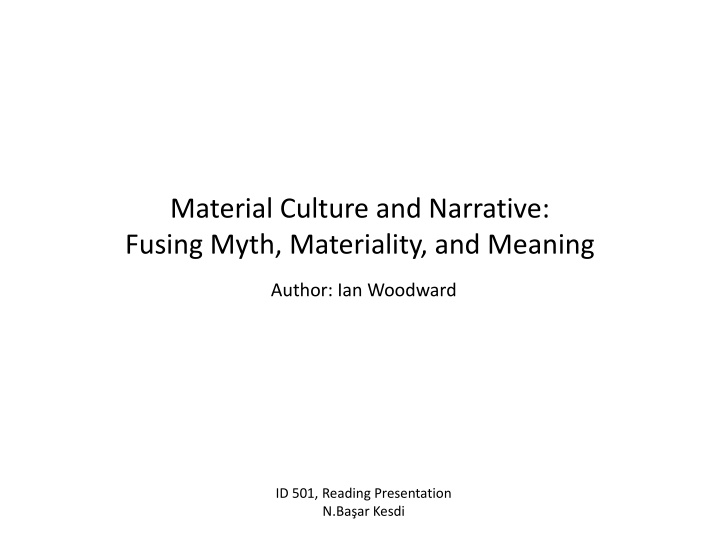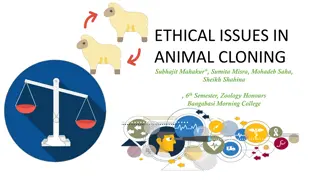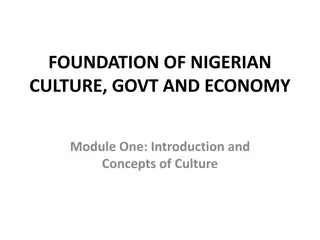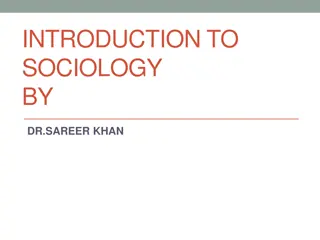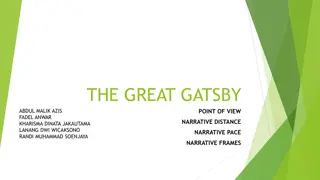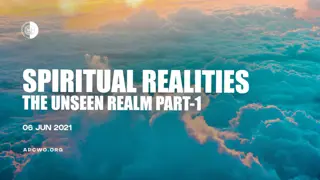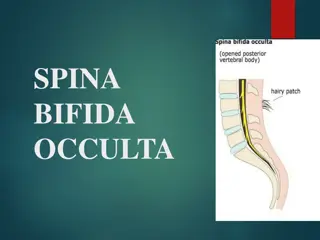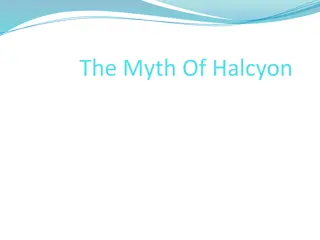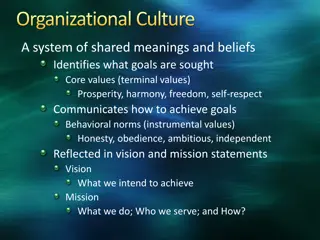Material Culture and Narrative: Fusing Myth and Materiality
Traversing the intriguing realm of narrative, myth, and material culture, author Ian Woodward delves deep into the fusion of myth and materiality to explore intricate layers of meanings and connections. With a unique perspective, this reading presentation sheds light on the profound interplay between tangible objects, stories, and significance in our cultural landscape.
Download Presentation

Please find below an Image/Link to download the presentation.
The content on the website is provided AS IS for your information and personal use only. It may not be sold, licensed, or shared on other websites without obtaining consent from the author.If you encounter any issues during the download, it is possible that the publisher has removed the file from their server.
You are allowed to download the files provided on this website for personal or commercial use, subject to the condition that they are used lawfully. All files are the property of their respective owners.
The content on the website is provided AS IS for your information and personal use only. It may not be sold, licensed, or shared on other websites without obtaining consent from the author.
E N D
Presentation Transcript
Material Culture and Narrative: Fusing Myth, Materiality, and Meaning Author: Ian Woodward ID 501, Reading Presentation N.Ba ar Kesdi
Without the fusion of myth and meaning with materiality, objects are just assamblages of materials.
Material Culture refers to the fact that Material things are one part of culture and they do cultural work. To express our ideas and to understand ourselves we need to attach those ideas to material things. (1995, Durkheim) Narratives constitute stories and with the stories linked to the material things we find a way to express ourselves and socialize
Materialization of elegance Precious Totem in Urban Settings Sacred Objects of Belonging In things external to us, we have an opportunity to objectify objectify ourselves and our ideals.
DEFINING NARRATIVES Narratives constitute stories To narrate is an essential aspects of being human. Narratives are not necessarily untruths, but they follow the logic of stories or trope. Narratives frequently come to life by being embodied in objects. And objects stimulate narratives, they afford us access into them. For example, a photograph remind us of our past, a public memorial lets us understand the collective stories. With narrators objects have their social life.
THREE ASPECTS OF NARRATIVIZATION 1 The narration of objects by individuals or groups Home decorations, Fashion, Photographs, Commemorative Objects Larger cultural narratives 2 Flag, Memorials, National Symbols Objects that narrate human activity directly 3 Computer Screens, Navigation Gadgets
1 Narrating Objects This process of narrativization tells us a great deal about the meanings people apply to their lives. People need narration to fix the meaning of objects, when meaning is open to debate or interpretation. We may know little about styles of wine and the ways of describing the taste of wine, but we may feel compelled in company to comment on or talk about the choice of wine at hand.
Having guests enter our home, we may feel need to talk about aspects of our home, color of the walls, furnitures we have, paintings on the wall etc..
Users and possessors of objects take an active voice in narration, telling the history, assosiations, and trajectories of an object. We agree that as objects they can come to represent us and, in part, we are judged by them. This is why knowing and fixing the meaning of this objects is compelling. In these fields formal knowledge is hard to claim, hard to expertise in, and consumers rely on whatever narratives they can to make sense of objects.(Warde, 1994)
2 Objects and Cultural Narratives Narratives also important components of culture, they also circulate within culture Barthes s idea is that people exposed to collective myths through their engagement with everyday objects and experiences, from motor vehicles to white goods, implements like cricket or baseball bats, to shoes and clothing. Barthes(1993:109) clarifies that myth is a system of communication or message. Consider mytical objects like the guitar of Hendrix, Trumpet of Miles Davis, Boxing gloves of Ali
Hummer Motor vehicle, for instance. Cardenas and Gorman (2007) assert that the material form of Hummer (a hypermasculine, dominating, ultraassertive, individualistic mobile fortress) fuse perfectly with dominant contemporary anxieties (teror, war, fear of street crime). Vehicle comes to materially embody a viable response to the narratives circulating within national culture.
Eiffel tower represents the attraction and myths of Paris, is a universal symbol of mobility and travel
Moving away from arenas of consumption and looking to the examples of punishment. Smith (2003,2008) shows that there were divergent cultural discourses surrounding guillotine. Smith argues that this objects has a range of cultural discourses, some rational and functional (rational and efficient punishment), some irrational (gothic story about horror and fear).
Alexanders study of the computer shows the cultural narratives that existed over time about this new object, and how it was narrated through public discourse alternately as a savior, or a threat. Alexander uses Durkheimian idea that human divide world into things and events that are sacred and profane. According to this idea computers are superbrain, superhuman, closest hings to GOD as a sacred object, the computer is colossal gadget, a Frankenstein monster, a mathematical dreadnought, and a figure of factory as a profane object.
The category of monuments and memorials are also important example of how objects reference history and link them to social ideas and collective desires. Auguste Rodin s sculpture The Burghers of Calais , based on a local story, been used as a monument throughout the world. The sculpture tells a very modern tale of social solidarity, suggesting that the heroes of our time are not like extraordinary individuals in earlier centuries. Story of this sculpture find its roots in history. Under the siege of England army, Edward III offered to spare the people of the city if any six of its top leaders would surrender themselves to him. People in the statue, are the burghers who sacrifice theirselves for the people of Calais.
3 Objects That Narrates Certain categories of technological objects actively may narrate human experiences. These are the objects displace human beings as relationship partners (Knorr Cetina, 1997) These objects actively tell the story a human would normally tell. Navigation system in a car offer a form of narration to the driver and passenger. Such technologies offer visual, acoustic and numeric guidance on route, location, and direction. For this elemantary and uninteresting narration Woodward define this type as simple and mundane.
Conclusion Objects are undeniably material. + They are enmeshed in a variety of private and larger cultural narratives. = Important personal and cultural objects transcend their material form as they become to have an extramaterial quality
Key Question Woodward (2009) defines narration of objects that narrates as simple and mundane. According to the technological developments how we may define future of this aspect of narration which acts like a displacement of human beings as relationship partners?
